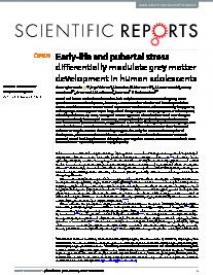Early-life and pubertal stress differentially modulate grey matter development in human adolescents
Animal and human studies have shown that both early-life traumatic events and ongoing stress episodes affect neurodevelopment, however, it remains unclear whether and how they modulate normative adolescent neuro-maturational trajectories. We characterized effects of early-life (age 0–5) and ongoing stressors (age 14–17) on longitudinal changes (age 14 to17) in grey matter volume (GMV) of healthy adolescents (n = 37). Timing and stressor type were related to differential GMV changes.
More personal early-life stressful events were associated with larger developmental reductions in GMV over anterior prefrontal cortex, amygdala and other subcortical regions; whereas ongoing stress from the adolescents’ social environment was related to smaller reductions over the orbitofrontal and anterior cingulate cortex. These findings suggest that early-life stress accelerates pubertal development, whereas an adverse adolescent social environment disturbs brain maturation with potential mental health implications: delayed anterior cingulate maturation was associated with more antisocial traits – a juvenile precursor of psychopathy.
In: Scientific Reports, ISSN 2045-2322 | 8 | June | Article number: 9201
https://doi.org/10.1038/s41598-018-27439-5
Published: 15 June 2018 ; https://creativecommons.org/licenses/by/4.0/


